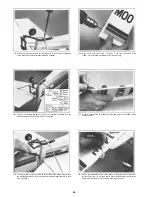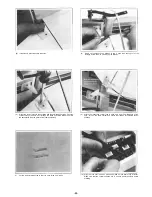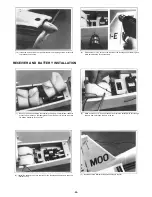
YOUR FIRST FLIGHT WHERE TO FLY
Before starting the engine check and make sure all screws are
tight that the hinges have not come loose, the control surfaces move
in the right directions according to your input on the transmitter, and
nobody is on your frequency
1 Start the engine and set the needle valve following the engine
manufacturer's instruction
2 Hold the plane tightly and move the throttle to full speed Pick
the plane up and hold it at a 45-60° nose up for 10-15
seconds The engine should run smoothly If it starts to die the
engine is too lean and the needle valve needs readjusting
needs readjusting
3 Taxi the plane to the end of the runway and point the nose into
the wind
4 Check that the control surfaces respond to the transmitter
commands
5 Gently advance the throttle to full power
6 Gently steer left or right as necessary to obtain a straight
take-off
7 After the plane has gained speed, gently pull back on the
elevator stick Do not allow the plane to climb too steeply
8 Keep the wings level and reduce the throttle some to obtain a
gentle climb
9 To turn gently move the aileron stick to the side and pull back
on the elevator If too much aileron is used the plane will bank
too steeply Make a wide gentle turn When the turn is
completed return the sticks to the center
10 After the plane passes by you make another wide 180 ° turn
11 When learning to fly it is easier to control the plane by facing
the direction the plane is going and looking over your shoulder
at it
12 Fly in a figure eight making left and right turns at the end of the
straights
13 Decide where you are going to land and gently turn into the
wind 500 800 feet downwind
14 When you know you can reach the landing area, reduce the
throttle You want the plane to gently descent towards the
landing area Keep the wings level and do no allow the nose to
rise This can produce a stall (a lack of lift) and the plane will
dive steeply
15 If the plane is going to be short of the landing area apply some
power to reach the landing area If the plane is too high apply
power and climb back up to some altitude and set up to land
again With practice you will be flying with more confidence
and able to make nice smooth landings on a runway The only
way to become a good pilot is to practice
If you are a novice pilot local area clubs have been formed and
are very willing to help you with any questions you may have Many
of the clubs even have club trainer airplanes that they will actually
teach you to fly with This helps prevent disappointing crashes on
your first flights Addresses of local area clubs can be located from
your local area hobby shop and/or by writing to Academy of Model
Aviation, 1810 Samuel Morse Drive, Reston, VA 22090
Assembled Diabolo .40
PRE-FLIGHT RADIO CHECK
With the batteries fully charged, turn on the transmitter and
receiver Move the control sticks a few times to make sure the control
surfaces move freely and proportionally with the movements of the
control stick Check that all the control responses are correct When
viewed from behind move the aileron control stick to the right The
right aileron should go up move the elevator stick down the elevator
should go up When the rudder control stick is moved to the left the
tailwheel should move to the left Also check that the throttle opens
up to full power when the throttle control stick is moved up or
forward
Before flying each day perform a range check of your radio
equipment as specified by the radio manufacturer As a general rule
for testing, follow the guidelines to the right
• Do all testing in an open are away from cars and buildings They
may cause signal interference
• Collapse the transmitter antenna so it is 6" to 8" long
• Set the plane so that the rudder is facing you
• Turn on the transmitter and receiver
• Walk away from the plane while moving the control sticks while
watching the control surfaces The surfaces should move when the
control stick is moved
• Most radios should have a range on the ground (antenna collapsed)
of 50 to 100 feet (see radio owner's manual) If the radio does not
pass this test the plane should not be flown and the radio sent for
repair.
ENTIRE CONTENTS © COPYRIGHT 1989
,INC.
-28-

































